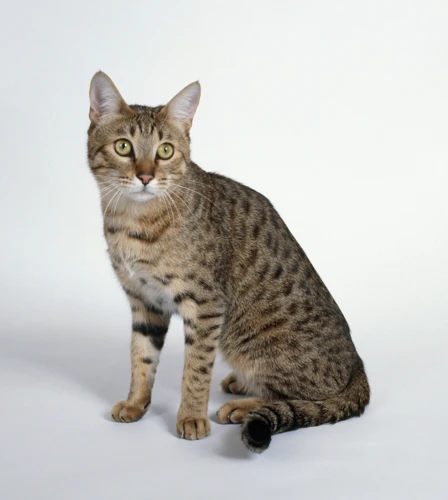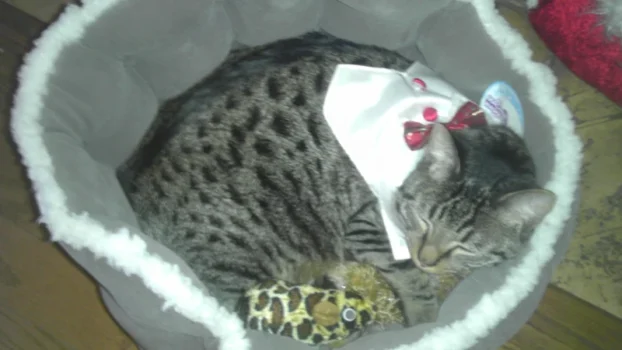Have you ever wondered why California Spangled cats love to climb? It’s a perplexing behavior that leaves many cat owners scratching their heads. But fear not, as we delve into the evolutionary roots of climbing and the role it plays in the life of California Spangled cats. Plus, we will provide you with some essential tips on how to create suitable climbing spaces to keep your feline friend happy and healthy. So, let’s explore this curious cat behavior together and discover ways to encourage safe and fun climbing activities for your beloved feline companion.
Why Do California Spangled Cats Love to Climb?

It’s no secret that California Spangled cats are known for their love of climbing. What makes these felines so enthusiastic about scaling heights and perching themselves atop furniture and other elevated surfaces? The answer lies in both their evolutionary history and their unique traits and behavior. Let’s explore the reasons behind their climbing habits and what they mean for your cat’s wellbeing in their environment. To learn more about California Spangled cats and their traits, check out our guide to their personality and behavior.
The Evolutionary Roots of Climbing
Throughout evolution, cats have developed a natural instinct to climb. This instinct is directly linked to their hunting behaviors, which involve stalking prey from above and pouncing when the opportunity arises. Climbing allows cats to reach higher vantage points, giving them a better view of their surroundings and increasing their chances of spotting potential prey. Additionally, climbing provides a sense of security and protection from predators in the wild, as cats are able to quickly escape to the safety of higher ground.
California Spangled Cats, in particular, are known for their love of climbing. This breed has a strong prey drive and an active personality, making climbing a natural outlet for their energy. By providing a variety of climbing spaces, owners can satisfy their cats’ natural instincts and reduce unwanted behaviors such as scratching furniture or curtains.
In the wild, cats would climb trees or rocky outcroppings to establish territory and protect their resources. This territorial behavior is also evident in California Spangled Cats, making climbing an important part of their social and emotional needs. By providing adequate climbing opportunities, owners can help prevent aggression and destructive behavior in their pets.
So, by providing suitable climbing spaces for your California Spangled Cat, you are fulfilling their natural instinct and encouraging a healthy behavior. It’s essential to understand the cat’s nature and provide an environment where they can feel comfortable. To make sure your cat is happy and engaged, consider introducing a variety of textures, heights, and inclines in their climbing spaces.
For additional advice on managing various behaviors associated with California Spangled Cats, see our guides on aggression, destructive behavior, children, health, and territorial behavior. Additionally, environmental enrichment can help keep your cat stimulated, happy, and healthy, so see our guide on California Spangled Cats and their environment to learn more.
The Role of Climbing in the Life of California Spangled Cats
California Spangled Cats are natural climbers and it is an essential component of their daily lives. Climbing provides them with a variety of benefits that contribute to their mental and physical well-being. Here are some of the key roles that climbing plays in the life of California Spangled Cats:
| Role of Climbing | Explanation |
|---|---|
| Exercise | Climbing is an excellent form of exercise that helps California Spangled Cats to maintain their physical health and agility. When cats climb, they engage their muscles and burn calories, which can prevent obesity and other health issues. |
| Exploration | For California Spangled Cats, climbing is a way to explore and investigate their surroundings. By climbing to new heights, they can discover new sights, sounds, and smells, which can stimulate their senses and satisfy their curiosity. |
| Safety | For California Spangled Cats, climbing serves as a means of protection and safety. By being able to climb to high places, they can escape danger or potential threats such as other animals or intruders. |
| Resting | Climbing also provides California Spangled Cats with a comfortable resting spot. They enjoy being perched high up as it gives them a sense of security and control over their surroundings. It is also a perfect place for them to take a nap or relax. |
| Natural Instinct | Finally, the ability to climb is deeply ingrained in the nature of California Spangled Cats. As descendants of wild cats, climbing is a natural instinct and they feel the need to demonstrate this behavior in their daily lives. |
Providing adequate climbing spaces is crucial for the well-being of California Spangled Cats, both physically and mentally. By fulfilling their natural instinct to climb, it is feasible to promote the natural behaviors of cats.
How to Provide Suitable Climbing Spaces for Your California Spangled Cat

When it comes to providing suitable climbing spaces for your California Spangled cat, it’s important to consider their instincts and preferences. Cats have a natural inclination to climb and explore their environment, so providing them with appropriate climbing options not only satisfies their needs but also helps to keep them mentally and physically stimulated. In this section, we’ll explore some tips and guidelines for creating a fun and safe climbing space for your feline friend. So, let’s dive in and discover what you can do to make your California Spangled cat’s climbing experience a happy and fulfilling one.
Consider Your Cat’s Climbing Preferences
When it comes to providing suitable climbing spaces for your California Spangled cat, it is important to consider their climbing preferences. Here are some factors to keep in mind:
1. Height: California Spangled cats love climbing to high places, so consider furniture that can offer an elevated perch, such as a tall cat tree or a wall-mounted shelf.
2. Type of Surface: Cats love different textures to climb on, so consider the type of material your climbing furniture is made of. For example, some cats prefer rough surfaces for scratching, while others prefer soft surfaces.
3. Vertical vs. Horizontal: Some cats love to climb vertically, while others prefer horizontal spaces to climb and play on. Consider purchasing furniture that accommodates your cat’s preferences.
4. Quantity: Some cats like to have a variety of climbing options, while others may prefer just one or two. Think about your cat’s behavior and personality to determine how many climbing spaces are suitable for them.
5. Location: Consider where your cat likes to spend most of their time. If they enjoy being in a particular room, make sure to provide climbing spaces in that area. Additionally, if your cat loves to look out the window, consider placing climbing furniture near a window.
By considering your cat’s climbing preferences, you can provide them with the most suitable and enjoyable climbing spaces possible. This can reduce the chances of your cat developing destructive behaviors or being bored.
Choose the Right Type of Climbing Furniture
When it comes to choosing the right type of climbing furniture for your California Spangled cat, there are several factors to consider. Here are some tips to keep in mind:
- Height: California Spangled cats love to climb to high places, so it’s important to choose furniture that allows them to do so. Look for cat trees or shelves that are at least 4-5 feet tall.
- Stability: The furniture should be sturdy enough to support your cat’s weight and movements. Check for materials such as thick wooden platforms or heavy-duty metal brackets that can hold the furniture securely in place.
- Diversity: Offer a variety of climbing options such as different textures, platforms, and angles. Consider purchasing a cat tree with multiple levels, or adding a wall-mounted shelf for your feline friend to explore.
- Safety Features: Look for climbing furniture with built-in safety features such as scratch-resistant surfaces, non-slip materials, and soft, cushioned landings. These features can prevent injuries and keep your cat safe during playtime.
- Decor: In addition to function, consider the aesthetic appeal of the climbing furniture. Choose colors and styles that match your home decor or reflect your cat’s personality.
By following these tips, you can choose the right type of climbing furniture that your California Spangled cat will love and enjoy for years to come. Remember to observe your cat’s behaviors and make adjustments as needed to ensure they are comfortable and safe during their climbing adventures.
Position the Climbing Furniture Strategically
When positioning the climbing furniture for your California Spangled cat, it’s important to take into account their natural behavior and preferences. Here are some tips for strategically placing the furniture to ensure maximum use and enjoyment:
- Location: Position the climbing furniture in areas where your cat likes to spend time, such as near windows or in the same room as their food and water bowls. This will encourage them to use the furniture regularly and associate it with positive experiences.
- Height: Place the climbing furniture at varying heights to allow your cat to simulate the experience of climbing trees in their natural habitat. This also allows them to retreat to higher ground if they feel anxious or threatened.
- Stability: Ensure the climbing furniture is stable and won’t wobble or tip over when your cat climbs on it. You can use wall anchors or other secure mounting methods to prevent accidents.
- Accessibility: Make sure the climbing furniture is easily accessible for your cat, particularly if they are elderly, have disabilities or are overweight. Avoid positioning it too high or too low, which can discourage use.
- Variety: Offer a variety of climbing surfaces and textures, such as sisal rope, carpet, and wood. This will keep your cat engaged and interested in using the furniture.
By taking these factors into account, you can position the climbing furniture in a way that encourages safe and enjoyable use for your California Spangled cat.
Make Climbing Safe and Fun
When it comes to providing climbing spaces for your California Spangled cat, making sure they are safe and fun is crucial. Here are some tips to create a safe and enjoyable climbing environment for your feline friend:
| Tip | Description |
|---|---|
| Install Sturdy Climbing Furniture | Make sure the climbing furniture is sturdy and won’t tip over when your cat is using it. Avoid cheaply made or poorly constructed furniture. |
| Provide Soft Landing Surfaces | Cats can easily injure themselves if they fall from a high surface. Providing soft landing surfaces, such as padded mats or cushions, can help prevent injuries. |
| Maintain Climbing Furniture Regularly | Regularly inspect and maintain your cat’s climbing furniture to ensure it is in good condition. Check for loose or broken parts and repair or replace as necessary. |
| Limit Climbing Heights | Avoid placing climbing furniture too high, especially if your cat is older or has mobility issues. Limiting climbing heights can help prevent falls and injuries. |
| Provide Climbing Challenges | Cats love a good challenge, so try to provide varied and interesting climbing obstacles. This can help keep your cat engaged and entertained while also providing exercise. |
| Supervise Your Cat While Climbing | While your California Spangled cat may be a skilled climber, accidents can still happen. Supervising your cat while they climb can help prevent injuries and ensure they are using the furniture safely. |
By taking these precautions and making sure that climbing furniture is safe and fun, you can provide your California Spangled cat with a stimulating and enjoyable environment that will satisfy their natural instincts.
Introduce New Climbing Spaces Gradually
When introducing new climbing spaces for your California Spangled Cat, it’s important to do so gradually. This is to prevent overwhelming your furry friend and to ensure that they feel comfortable and safe in their new space.
One way to introduce new climbing spaces is by using cat trees or shelves. Start by positioning one or two pieces of climbing furniture in an area your cat frequents and gradually add more over time. This allows your cat to become familiar with the new space and to adjust to the new heights and textures of their climbing furniture.
Another way to introduce new climbing spaces is by using cardboard boxes or tunnels. Cats love to explore small spaces and these types of climbing spaces provide an opportunity for them to do so. Start by leaving a box or tunnel in a quiet area and allow your cat to investigate at their own pace. Once they have become familiar with it, you can move the box or tunnel to a more visible and accessible location.
It’s important to note that not all cats will feel comfortable exploring new spaces immediately. If your cat seems hesitant, try adding familiar items such as their favorite toys or bedding to the new space. This can help to create a sense of familiarity and comfort.
Introducing new climbing spaces gradually also allows you to observe your cat’s behavior and preferences. This will give you an idea of what types of climbing furniture they prefer and where they like to climb. You can then use this information to add new pieces of climbing furniture in areas where your cat is most likely to use them.
Introducing new climbing spaces gradually is an important step in keeping your California Spangled Cat happy and healthy. By allowing them to adjust to their new environment at their own pace, you can ensure that they feel safe, comfortable, and confident in their climbing abilities.
| Introducing New Climbing Spaces Gradually |
|---|
| Start with one or two climbing furniture |
| Add more climbing furniture over time |
| Use cardboard boxes or tunnels |
| Add familiar items to new spaces |
| Observe your cat’s behavior and preferences |
Provide Environmental Enrichment Opportunities
Cats, especially the California Spangled breed, are no ordinary pets. They require constant stimulation and adventure to prevent boredom and destructive behavior. One way to provide environmental enrichment for your California Spangled cat is to offer a variety of climbing opportunities and related activities. Here are some suggestions:
| Environmental Enrichment Opportunities | Description |
|---|---|
| Scratching Posts | California Spangled cats love to scratch and climb on things. Provide them with a variety of sturdy scratching posts of different heights, textures and shapes to help maintain their claws, exercise their muscles, and satisfy their natural desire. |
| Hideaways and Cubbies | California Spangled cats love to have cozy spaces to retreat to when they feel tired or anxious. Place cat trees, shelves or boxes in different areas of your home, providing your cat with opportunities to hide, nap and observe its surroundings from a vantage point. |
| Toys and Baubles | California Spangled cats love to play with toys and objects that are shiny or make noise. Provide your cat with a selection of toys, such as balls, feathers, catnip stuffed mice or crinkly bags, to keep them entertained and help them expend energy. |
| Climbing Walls | Create a climbing wall for your California Spangled cat using planks of wood, carpet, or sisal rope. This will allow your cat to climb to new heights, explore its environment and get the necessary exercise it needs to stay healthy. |
Remember to rotate these enrichment opportunities periodically so your cat does not get bored. In addition to providing physical enrichment opportunities, consider mental stimulation and socialization opportunities. Play games with your cat and spend quality bonding time with it. Provide adequate food, water and litter resources. Your California Spangled cat deserves to have a happy and healthy life.
Tips for Training Your California Spangled Cat to Climb Safely
As much as California Spangled cats are natural climbers, it’s still necessary to train them to climb safely. This is especially important if you live in an apartment or don’t have access to outdoor spaces. Fortunately, cats can be trained, and with some patience and persistence, you can teach your feline friend how to climb appropriately and avoid any accidents. Here are some effective tips to help you train your California Spangled cat to climb safely.
Use Positive Reinforcement Techniques
Positive reinforcement is one of the most effective techniques for training cats to climb safely. Rather than punishing your California Spangled Cat for unwanted behavior, focus on rewarding them for positive behavior. This approach creates a positive association with climbing and encourages your cat to repeat those behaviors. Here are some positive reinforcement techniques to try:
1. Treats: Reward your cat with a favorite treat after a successful climb. This serves as an immediate reward and reinforces good behavior.
2. Vocal Praise: Use a happy, upbeat tone of voice to praise your cat when they climb. This lets them know they’ve done something good and helps build a positive association with climbing.
3. Playtime: Create a fun game that involves climbing and offer playtime as a reward for good climbing behavior.
4. Petting and Affection: Positive physical reinforcement, like petting and affection, can be a powerful motivator for some cats. Use this as a reward for good climbing behavior.
Remember to keep your rewards consistent and tailored to your individual cat’s preferences. By reinforcing positive climbing behaviors, you can build a strong foundation for a safe and enjoyable climbing experience for your California Spangled Cat.
Be Patient and Persistent
Training a California Spangled Cat to climb safely requires patience and persistence. Cats are creatures of habit, and it may take some time for them to become comfortable with new climbing spaces and behaviors.
Patience is key when training your cat to climb. It’s important to remember that each cat is unique and learns at their own pace. Some cats may take to climbing right away, while others may need more time and encouragement. It’s crucial to remain calm and patient throughout the training process, as cats can sense when their humans are feeling frustrated or stressed.
Persistence is also important when training your California Spangled Cat to climb safely. It’s unlikely that your cat will become a climbing expert overnight, so it’s important to continue working with them until they feel comfortable in their climbing spaces. Consistent practice and repetition will help reinforce positive behaviors and make climbing come more naturally to your cat.
One effective way to be both patient and persistent is to use positive reinforcement techniques. This involves rewarding your cat for safe and appropriate climbing behavior, such as using a scratching post instead of climbing on curtains. Rewards can include treats, toys, or praise, and can help encourage your cat to continue exhibiting the desired behavior.
It’s also important to be aware of your cat’s limitations and take things at their pace. If your cat seems overwhelmed or stressed, take a break or slow down the training process. Training should be an enjoyable and positive experience for both you and your cat.
Being patient and persistent is key to training your California Spangled Cat to climb safely. Using positive reinforcement techniques and being aware of your cat’s limitations can help make the training process a positive and successful experience for everyone involved.
| Key Points |
|---|
| – Patience is important when training |
| – Persistence is necessary to reinforce positive behaviors |
| – Use positive reinforcement techniques |
| – Be aware of your cat’s limitations |
| – Keep training enjoyable and positive for both you and your cat |
Encourage Safe Climbing Behaviors
Encouraging safe climbing behaviors in your California Spangled Cat is crucial to their overall well-being. Here are some tips to help you get started:
- Provide guidance: Cats may not always be aware of safe climbing options, so it’s important to guide them towards appropriate surfaces and pieces of furniture. Encourage them to explore their climbing options and reward them when they choose safe options.
- Teach them jumping skills: Jumping is an important aspect of climbing for cats, so it’s important to teach them how to jump safely and effectively. Set up low-level obstacles for your cat to jump over and reward them when they make it over the obstacle safely.
- Teach them to descend safely: Climbing down can be more difficult than climbing up for some cats, so it’s important to teach them how to do it safely. Encourage them to take things slow and reward them when they make it down safely.
- Provide appropriate scratching surfaces: Cats love to scratch, and it’s important to provide them with appropriate scratching surfaces to prevent them from scratching furniture or other inappropriate surfaces. Make sure to regularly trim your cat’s claws to reduce the likelihood of injury.
- Supervise your cat: Supervising your cat while they climb is important to ensure that they stay safe and don’t get stuck in an unreachable place. Regularly check any climbing spaces to make sure they remain safe and secure for your cat.
By encouraging safe climbing behaviors in your California Spangled Cat, you can help them stay safe and healthy while also allowing them to fulfill their natural instinct to climb and explore their environment.
Discourage Unsafe Climbing Behaviors
As much as we want our California Spangled Cats to enjoy their climbing spaces, it is also important to discourage unsafe climbing behaviors. Here are some tips on how to go about it:
| Tip | Description |
|---|---|
| Provide alternative activities | If your cat is showing unsafe climbing behaviors such as scratching furniture or climbing on countertops, provide them with alternative activities and toys to redirect their attention. This could include scratching posts or climbing towers located in appropriate spots. |
| Use deterrents | If your cat continues to exhibit unsafe climbing behaviors, consider using deterrents such as double-sided tape or citronella sprays. These products are unpleasant for cats and can help discourage them from climbing where they shouldn’t. |
| Supervise your cat | Keep an eye on your California Spangled Cat while they are climbing or exploring new spaces. This allows you to intervene if they begin to engage in unsafe behavior. |
| Block off unsafe areas | If there are certain areas of your home that are too dangerous for your cat to climb, such as open balconies or high bookshelves, use barriers to block off access. This ensures your cat’s safety while still allowing them to enjoy their climbing spaces. |
By discouraging unsafe behaviors, we can ensure that our California Spangled Cats stay safe and happy in their climbing spaces. Remember to always provide alternative activities and supervise your cat while they climb.
Offer Alternative Activities and Diversions
Cats are known for their playful and curious nature, which is why it’s important to provide them with a variety of activities and diversions, especially if they are indoor cats. Offering alternative activities and diversions can help keep your California Spangled cat mentally and physically stimulated, reducing the likelihood of destructive behavior or boredom.
One great way to offer alternative activities is by using toys that encourage exercise and play. Interactive toys such as laser pointers and feather wands can provide hours of entertainment for your cat. Toys that mimic natural prey, such as mice or birds, can also be great for your cat’s mental stimulation.
Another way to keep your cat entertained is by providing them with scratching posts and pads. Not only do these objects help keep your cat’s claws healthy, but they also provide a fun activity that can help redirect their energy away from potentially destructive behaviors.
Consider setting up a window perch or bird feeder outside of a window. This gives your cat a place to relax and observe the outside world, which can be both entertaining and calming. You can also place a bed or blanket in a sunny spot for your cat to lounge in.
Finally, cats love routine and predictability. Try to maintain a consistent feeding schedule and playtime routine. If your cat knows when to expect playtime, they will be less likely to engage in destructive behavior. Remember to always supervise your cat during playtime and to offer a variety of activities to prevent boredom.
Here is a table of alternative activities and diversions for your California Spangled cat:
| Toys | Scratching Posts/Pads | Window Perches/Bird Feeders | Sunny Beds/Blankets |
| Laser pointer | Carpeted scratching post | Window perch with suction cups | Sunny bed with cushion |
| Feather wand | Sisal scratching pad | Bird feeder outside window | Fleece blanket in sunny spot |
| Mice/bird toys | Cardboard scratching pad | Small birdhouse outside window | |
| Tunnel toy | Hanging scratching post |
Remember, each cat is unique and may have different preferences for play and activities. Be sure to observe your California Spangled cat’s behaviors and adjust their environment accordingly to keep them happy and healthy.
Conclusion
After learning about the evolutionary roots of climbing for cats and the specific role of climbing in the life of California Spangled cats, it is clear that providing them with suitable climbing spaces is crucial for their physical and mental well-being.
By considering your cat’s climbing preferences and choosing the right type of climbing furniture, as well as strategically positioning it in your home, you can create a safe and fun environment for your cat to climb and play. Gradually introducing new climbing spaces and offering environmental enrichment opportunities can further enhance your cat’s experience.
However, it’s important to keep in mind that training your California Spangled cat to climb safely is an ongoing process that requires patience, persistence, and positive reinforcement techniques. Encouraging safe climbing behaviors and discouraging unsafe ones, as well as offering alternative activities and diversions, will help your cat develop good habits and avoid potential injury.
In conclusion, providing suitable climbing spaces for your California Spangled cat is a crucial aspect of their overall health and happiness. By following the tips and strategies outlined in this article, you can enhance your cat’s climbing experience and create a safe and stimulating environment for them to thrive in.
Frequently Asked Questions
How high can California Spangled Cats climb?
California Spangled Cats can climb to impressive heights, up to 6 feet or more. They have strong legs and sharp claws that allow them to maneuver easily up tall structures, such as bookshelves, cat trees, and scratching posts.
Why do California Spangled Cats enjoy climbing so much?
Climbing is a natural instinct for cats. For California Spangled Cats, climbing provides them with exercise, a sense of security, and an opportunity to survey their territory from a high vantage point. This enables them to act on their predatory behavior, to able to control their living space better, and help hide in plain sight when hunting.
Is it safe to let my California Spangled Cat climb outside?
No, it is not safe to let your California Spangled Cat climb outside where they could be hurt, get lost or encounter dangerous animals that may be larger than them. Always provide a safe space for your California Spangled Cat to climb indoors, such as a structure that is stable and built to accommodate their needs.
What kind of climbing furniture is suitable for California Spangled Cats?
The ideal climbing furniture for California Spangled Cats is sturdy, providing a stable platform from which they can survey their surroundings. Cat trees, scratching posts, and shelves are some of the most popular choices. Multi-leveled structures, with hiding places, perches and scratching posts are good options for them.
What’s the difference between a cat tree and a scratching post?
A scratching post is a tall, upright post that provides a surface for cats to scratch, whereas a cat tree has both scratching surfaces and multiple levels for climbing and playing. While scratching posts are important for maintaining a cat’s claws, cat trees provide more enrichment.
Can I make my own climbing furniture for my California Spangled Cat?
Yes, it is possible to make your own climbing furniture for your California Spangled Cat. However, homemade structures should be safe, sturdy, and designed to accommodate your cat’s needs. If in doubt, you can seek assistance from a DIY cat furniture guide or consult with an expert in the field.
How can I encourage my California Spangled Cat to climb?
You can encourage your California Spangled Cat to climb by placing some of their favorite toys on the structure and using treats as incentives. Make sure that there is no overstimulation, excessive force, or risks to their safety. Positive reinforcement techniques will encourage them to use their climbing furniture more frequently on their own.
What should I do if my California Spangled Cat refuses to use their climbing furniture?
If your California Spangled Cat refuses to use their climbing furniture, try placing it in a different location or experimenting with different species of furniture, such as adding shelves or window perches. Always encourage and reward your cat when they successfully use their climbing furniture but don’t punish them for not doing so.
Is it safe for my California Spangled Cat to climb on bookshelves?
No, it is not safe for your California Spangled Cat to climb on bookshelves or other pieces of furniture that are not designed with cats in mind. Heavy books and fragile items on the shelves may be at risk of falling or being broken. Keep important items out of the way and provide alternative areas for your cat to climb instead.
Do California Spangled Cats ever lose interest in climbing?
No, California Spangled Cats never lose interest in climbing as it is a natural behavior that is essential to their wellbeing. However, there may be times when your cat is less interested in climbing due to other sources of entertainment or stress. You can encourage them to climb by introducing new climbing spaces or stimuli-related activities, such as scratching posts or catnip toys.







